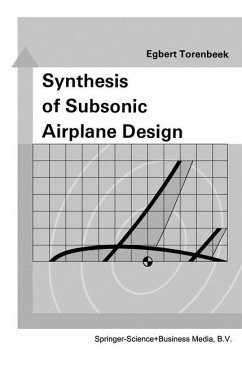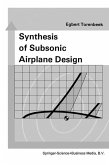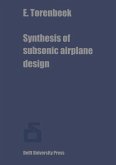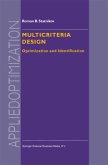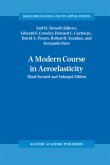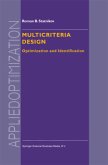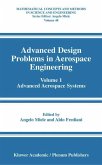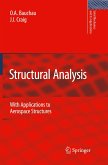E. Torenbeek
Synthesis of Subsonic Airplane Design
An introduction to the preliminary design of subsonic general aviation and transport aircraft, with emphasis on layout, aerodynamic design, propulsion and performance
E. Torenbeek
Synthesis of Subsonic Airplane Design
An introduction to the preliminary design of subsonic general aviation and transport aircraft, with emphasis on layout, aerodynamic design, propulsion and performance
- Broschiertes Buch
- Merkliste
- Auf die Merkliste
- Bewerten Bewerten
- Teilen
- Produkt teilen
- Produkterinnerung
- Produkterinnerung
Since the education of aeronautical engineers at Delft University of Technology started in 1940 under tae inspiring leadership of Professor H.J. van der Maas, much emphasis has been placed on the design of aircraft as part of the student's curriculum. Not only is aircraft design an optional subject for thesis work, but every aeronautical student has to carry out a preliminary airplane design in the course of his study. The main purpose of this preliminary design work is to enable the student to synthesize the knowledge ob tained separately in courses on aerodynamics, aircraft performances,…mehr
Andere Kunden interessierten sich auch für
![Synthesis of Subsonic Airplane Design Synthesis of Subsonic Airplane Design]() E. TorenbeekSynthesis of Subsonic Airplane Design66,99 €
E. TorenbeekSynthesis of Subsonic Airplane Design66,99 €![Synthesis of subsonic airplane design Synthesis of subsonic airplane design]() E. TorenbeekSynthesis of subsonic airplane design82,99 €
E. TorenbeekSynthesis of subsonic airplane design82,99 €![Multicriteria Design Multicriteria Design]() R. B. StatnikovMulticriteria Design81,99 €
R. B. StatnikovMulticriteria Design81,99 €![A Modern Course in Aeroelasticity A Modern Course in Aeroelasticity]() E.H. Dowell / Edward F. Crawley / Howard C. Curtiss Jr. / David A. Peters / Robert H. Scanlan / Fernando Sisto (Hgg.)A Modern Course in Aeroelasticity163,99 €
E.H. Dowell / Edward F. Crawley / Howard C. Curtiss Jr. / David A. Peters / Robert H. Scanlan / Fernando Sisto (Hgg.)A Modern Course in Aeroelasticity163,99 €![Multicriteria Design Multicriteria Design]() R. B. StatnikovMulticriteria Design77,99 €
R. B. StatnikovMulticriteria Design77,99 €![Advanced Design Problems in Aerospace Engineering Advanced Design Problems in Aerospace Engineering]() Advanced Design Problems in Aerospace Engineering116,99 €
Advanced Design Problems in Aerospace Engineering116,99 €![Structural Analysis Structural Analysis]() O. A. BauchauStructural Analysis40,99 €
O. A. BauchauStructural Analysis40,99 €-
-
-
Since the education of aeronautical engineers at Delft University of Technology started in 1940 under tae inspiring leadership of Professor H.J. van der Maas, much emphasis has been placed on the design of aircraft as part of the student's curriculum. Not only is aircraft design an optional subject for thesis work, but every aeronautical student has to carry out a preliminary airplane design in the course of his study. The main purpose of this preliminary design work is to enable the student to synthesize the knowledge ob tained separately in courses on aerodynamics, aircraft performances, stability and con trol, aircraft structures, etc. The student's exercises in preliminary design have been directed through the years by a number of staff members of the Department of Aerospace Engineering in Delft. The author of this book, Mr. E. Torenbeek, has made a large contribution to this part of the study programme for many years. Not only has he acquired vast experience in teaching airplane design at university level, but he has also been deeply involved in design-oriented re search, e.g. developing rational design methods and systematizing design information. I am very pleased that this wealth of experience, methods and data is now presented in this book.
Hinweis: Dieser Artikel kann nur an eine deutsche Lieferadresse ausgeliefert werden.
Hinweis: Dieser Artikel kann nur an eine deutsche Lieferadresse ausgeliefert werden.
Produktdetails
- Produktdetails
- Verlag: Delft University Press / Springer / Springer Netherlands
- Artikelnr. des Verlages: 978-90-481-8273-2
- Softcover reprint of hardcover 1st ed. 1982
- Seitenzahl: 624
- Erscheinungstermin: 25. Dezember 2010
- Englisch
- Abmessung: 235mm x 155mm x 34mm
- Gewicht: 924g
- ISBN-13: 9789048182732
- ISBN-10: 9048182735
- Artikelnr.: 32106641
- Herstellerkennzeichnung Die Herstellerinformationen sind derzeit nicht verfügbar.
- Verlag: Delft University Press / Springer / Springer Netherlands
- Artikelnr. des Verlages: 978-90-481-8273-2
- Softcover reprint of hardcover 1st ed. 1982
- Seitenzahl: 624
- Erscheinungstermin: 25. Dezember 2010
- Englisch
- Abmessung: 235mm x 155mm x 34mm
- Gewicht: 924g
- ISBN-13: 9789048182732
- ISBN-10: 9048182735
- Artikelnr.: 32106641
- Herstellerkennzeichnung Die Herstellerinformationen sind derzeit nicht verfügbar.
1. General Aspects of Aircraft Configuration Development.- 2. The General Arrangement.- 3. Fuselage Design.- 4. An Appreciation of Subsonic Engine Technology.- 5. Design for Performance.- 6. Choice of the Engine and Propeller and Installation of the Powerplant.- 7. An Introduction to Wing Design.- 8. Airplane Weight and Balance.- 9. Preliminary Tailplane Design.- 10. The Undercarriage Layout.- 11. Analysis of Aerodynamic and Operational Characteristics.- 12. Evaluation and Presentation of a Preliminary Design.- References.- Appendix A. Definitions Relating to the Geometry and Aerodynamic Characteristics of Airfoils.- A-1. General.- A-2. Wing sections.- A-2.1. Geometric definitions.- A-2.2. Aerodynamic definitions.- A-2.3. Nomenclature for some NACA sections.- A-3. Wings.- A-3.1. Wing planform.- A-3.2. (Wing) twist and incidence.- A-3.3. Aerodynamic definitions.- References.- Appendix B. The Computation of Circumferences, Areas and Volumes of Curves, Sections and Bodies.- B-1. Fuselage.- B-1.1. General method.- B-1.2. Quick method for bodies of revolution.- B-2. Wings and tailplanes.- B-3. Fuel tank volume.- B-4. Engine nacelles and air ducts.- References.- Appendix C. Prediction of Wing Structural Weight.- C-1. Introduction.- C-2. Basic wing structure weight.- C-3. High lift devices, spoilers and speedbrakes.- C-4. Wing group weight.- Appendix D. The Weight Penalty Method for Fuselage Structural Weight Prediction.- D-1. Survey of the methodology.- D-2. Gross shell weight.- D-2.1. Gross skin weight.- D-2.2. Gross stringer and longeron weight.- D-2.3. Gross standard frame weight.- D-3. Gross shell modifications.- D-3.1. Removed material.- D-3.2. Doors, hatches, windows and enclosures.- D-4. Flooring.- D-4.1. Passenger cabin and freight hold floors.- D-4.2. Various other floors.- D-5. Pressure bulkheads and frames.- D-5.1. Pressure cabin bulkheads.- D-5.2. Wheelbays for retractable undercarriages.- D-6. Support structure.- D-6.1. Wing/fuselage connection.- D-6.2. Engine support structure.- D-6.3. Other support structures.- D-7. Additional weight items.- References.- Appendix E. Prediction Methods for Lift and Pitching Moment of Aircraft in the En Route Configuration.- E-1. Applicability of the methods.- E-2. Contributions to the lift.- E-3. Lifting properties of airfoil sections.- E-3.1. The zero-lift angle.- E-3.2. Lift-curve slope.- E-3.3. Maximum lift.- E-4. Wing lift and lift distribution.- E-4.1. Lift-curve slope.- E-4.2. Spanwise lift distribution.- E-4.3. Zero-lift angle.- E-4.4. Maximum lift.- E-5. Pitching moment of the wing.- E-5.1. Aerodynamic center.- E-6. Wing/fuselage interference effects on lift.- E-7. Wing/fuselage pitching moment.- E-7.1. Aerodynamic center.- E-8. Nacelle and propeller contributions.- E-9. Lift of the complete aircraft.- E-9.1. Tailplane lift.- E-9.2. Total trimmed airplane lift.- E-9.3. Wing/body incidence.- E-9.4. Trimmed lift curve.- E-10. Airplane pitching moment and neutral point (stick fixed).- E-10.1. The stick-fixed neutral point.- E-10.2. Horizontal stabilizer incidence.- E-10.3. Pitching moment curve.- References.- Appendix F. Prediction of the Airplane Polar at Subcritical Speeds in the En Route Configuration.- F-1. Drag components.- F-2. Primary components of vortex-induced drag.- F-2.1. Untwisted plane wings.- F-2.2. Drag due to twist.- F-2.3. Wing tip correction on vortex-induced drag.- F-2.4. Vortex drag induced by fuselage lift.- F-2.5. Nacelle contribution.- F-2.6. Horizontal tailplane contribution.- F-3. Profile drag of smooth, isolated major components.- F-3.1. The flat plate analogy.-F-3.2. Wing sections.- F-3.3. Wings.- F-3.4. Fuselages and tail booms.- F-3.5. Engine nacelles.- F-3.6. Tailplane profile drag.- F-4. Subcritical interference effects and corrections.- F-4.1. Wetted area corrections.- F-4.2. Wing/fuselage interference.- F-4.3. Nacelle/airframe interference.- F-4.4. Tailplane/airframe interference.- F-5. Protuberances, surface imperfections and other extra's.- F-5.1. Fixed undercarriages.- F-5.2. Canopies and windshields.- F-5.3. Wheel-well fairings and blisters.- F-5.4. External fuel tanks.- F-5.5. Streamlined struts.- F-5.6. Powerplant installation drag.- F-5.7. Excrescences, surface imperfections and other extra's.- References.- Appendix G. Prediction of Lift and Drag in The Low-Speed Configuration.- G-1. Introduction.- G-2. Effect of trailing-edge flap deflection on airfoil section lift.- G-2.1. General aspects.- G-2.2. Lift increment at zero angle of attack.- G-2.3. Maximum lift coefficient.- G-2.4. Lift-curve slope.- G-3. Lift of aircraft with deflected trailing-edge flaps.- G-3.1. Wing lift.- G-3.2. Various contributions.- G-3.3. Contribution of the horizontal tailplane.- G-4. Prediction of the low-speed drag polar.- G-4.1. Profile drag.- G-4.2. Vortex-induced drag.- G-4.3. Trim drag.- G-5. Leading-edge high-lift devices.- G-5.!.. Sections with plain leading-edge flaps.- G-5.2. Sections with slats and Krueger flaps.- G-5.3. Wing lift with leading-edge devices.- G-5.4. Drag due to leading-edge devices.- G-6. Drag due to extension of a retractable undercarriage.- G-7. Ground effects.- G-7.1. Ground effect on lift.- G-7.2. Ground effect on drag.- G-8. Drag due to engine failure.- G-8.1. Engine windmilling drag.- G-8.2. Propeller drag.- G-8.3. Drag due to the asymmetric flight condition.- References.- Appendix H. Procedures forComputing Turbo-Engine Performance for Aircraft Project Design Work.- H-1. Scope of the method.- H-2. The gas generator.- H-3. Specific performance of straight jet engines.- H-4. Specific performance of turbofan engines.- H-5. Thrust lapse rates, intake and exhaust areas of turbojet and turbofan engines.- H-6. Specific performance of turboprop engines.- H-7. Cycle efficiencies and pressure losses.- References.- Appendix J. Principal Data of the Us and Icao Standard Atmospheres.- Appendix K. The Definition and Calculation of the Takeoff Field Length Required for Civil Transport Aircraft.- K-1. Reference distance definitions.- K-2. Reference speeds.- K-3. Procedure for determining the takeoff field length.- K-4. Methods and data for the analysis of the takeoff.- K-4.3. The rotation phase.- K-4.4. The airborne phase.- K-4.5. The stopping distance.- References.
1. General Aspects of Aircraft Configuration Development.- 2. The General Arrangement.- 3. Fuselage Design.- 4. An Appreciation of Subsonic Engine Technology.- 5. Design for Performance.- 6. Choice of the Engine and Propeller and Installation of the Powerplant.- 7. An Introduction to Wing Design.- 8. Airplane Weight and Balance.- 9. Preliminary Tailplane Design.- 10. The Undercarriage Layout.- 11. Analysis of Aerodynamic and Operational Characteristics.- 12. Evaluation and Presentation of a Preliminary Design.- References.- Appendix A. Definitions Relating to the Geometry and Aerodynamic Characteristics of Airfoils.- A-1. General.- A-2. Wing sections.- A-2.1. Geometric definitions.- A-2.2. Aerodynamic definitions.- A-2.3. Nomenclature for some NACA sections.- A-3. Wings.- A-3.1. Wing planform.- A-3.2. (Wing) twist and incidence.- A-3.3. Aerodynamic definitions.- References.- Appendix B. The Computation of Circumferences, Areas and Volumes of Curves, Sections and Bodies.- B-1. Fuselage.- B-1.1. General method.- B-1.2. Quick method for bodies of revolution.- B-2. Wings and tailplanes.- B-3. Fuel tank volume.- B-4. Engine nacelles and air ducts.- References.- Appendix C. Prediction of Wing Structural Weight.- C-1. Introduction.- C-2. Basic wing structure weight.- C-3. High lift devices, spoilers and speedbrakes.- C-4. Wing group weight.- Appendix D. The Weight Penalty Method for Fuselage Structural Weight Prediction.- D-1. Survey of the methodology.- D-2. Gross shell weight.- D-2.1. Gross skin weight.- D-2.2. Gross stringer and longeron weight.- D-2.3. Gross standard frame weight.- D-3. Gross shell modifications.- D-3.1. Removed material.- D-3.2. Doors, hatches, windows and enclosures.- D-4. Flooring.- D-4.1. Passenger cabin and freight hold floors.- D-4.2. Various other floors.- D-5. Pressure bulkheads and frames.- D-5.1. Pressure cabin bulkheads.- D-5.2. Wheelbays for retractable undercarriages.- D-6. Support structure.- D-6.1. Wing/fuselage connection.- D-6.2. Engine support structure.- D-6.3. Other support structures.- D-7. Additional weight items.- References.- Appendix E. Prediction Methods for Lift and Pitching Moment of Aircraft in the En Route Configuration.- E-1. Applicability of the methods.- E-2. Contributions to the lift.- E-3. Lifting properties of airfoil sections.- E-3.1. The zero-lift angle.- E-3.2. Lift-curve slope.- E-3.3. Maximum lift.- E-4. Wing lift and lift distribution.- E-4.1. Lift-curve slope.- E-4.2. Spanwise lift distribution.- E-4.3. Zero-lift angle.- E-4.4. Maximum lift.- E-5. Pitching moment of the wing.- E-5.1. Aerodynamic center.- E-6. Wing/fuselage interference effects on lift.- E-7. Wing/fuselage pitching moment.- E-7.1. Aerodynamic center.- E-8. Nacelle and propeller contributions.- E-9. Lift of the complete aircraft.- E-9.1. Tailplane lift.- E-9.2. Total trimmed airplane lift.- E-9.3. Wing/body incidence.- E-9.4. Trimmed lift curve.- E-10. Airplane pitching moment and neutral point (stick fixed).- E-10.1. The stick-fixed neutral point.- E-10.2. Horizontal stabilizer incidence.- E-10.3. Pitching moment curve.- References.- Appendix F. Prediction of the Airplane Polar at Subcritical Speeds in the En Route Configuration.- F-1. Drag components.- F-2. Primary components of vortex-induced drag.- F-2.1. Untwisted plane wings.- F-2.2. Drag due to twist.- F-2.3. Wing tip correction on vortex-induced drag.- F-2.4. Vortex drag induced by fuselage lift.- F-2.5. Nacelle contribution.- F-2.6. Horizontal tailplane contribution.- F-3. Profile drag of smooth, isolated major components.- F-3.1. The flat plate analogy.-F-3.2. Wing sections.- F-3.3. Wings.- F-3.4. Fuselages and tail booms.- F-3.5. Engine nacelles.- F-3.6. Tailplane profile drag.- F-4. Subcritical interference effects and corrections.- F-4.1. Wetted area corrections.- F-4.2. Wing/fuselage interference.- F-4.3. Nacelle/airframe interference.- F-4.4. Tailplane/airframe interference.- F-5. Protuberances, surface imperfections and other extra's.- F-5.1. Fixed undercarriages.- F-5.2. Canopies and windshields.- F-5.3. Wheel-well fairings and blisters.- F-5.4. External fuel tanks.- F-5.5. Streamlined struts.- F-5.6. Powerplant installation drag.- F-5.7. Excrescences, surface imperfections and other extra's.- References.- Appendix G. Prediction of Lift and Drag in The Low-Speed Configuration.- G-1. Introduction.- G-2. Effect of trailing-edge flap deflection on airfoil section lift.- G-2.1. General aspects.- G-2.2. Lift increment at zero angle of attack.- G-2.3. Maximum lift coefficient.- G-2.4. Lift-curve slope.- G-3. Lift of aircraft with deflected trailing-edge flaps.- G-3.1. Wing lift.- G-3.2. Various contributions.- G-3.3. Contribution of the horizontal tailplane.- G-4. Prediction of the low-speed drag polar.- G-4.1. Profile drag.- G-4.2. Vortex-induced drag.- G-4.3. Trim drag.- G-5. Leading-edge high-lift devices.- G-5.!.. Sections with plain leading-edge flaps.- G-5.2. Sections with slats and Krueger flaps.- G-5.3. Wing lift with leading-edge devices.- G-5.4. Drag due to leading-edge devices.- G-6. Drag due to extension of a retractable undercarriage.- G-7. Ground effects.- G-7.1. Ground effect on lift.- G-7.2. Ground effect on drag.- G-8. Drag due to engine failure.- G-8.1. Engine windmilling drag.- G-8.2. Propeller drag.- G-8.3. Drag due to the asymmetric flight condition.- References.- Appendix H. Procedures forComputing Turbo-Engine Performance for Aircraft Project Design Work.- H-1. Scope of the method.- H-2. The gas generator.- H-3. Specific performance of straight jet engines.- H-4. Specific performance of turbofan engines.- H-5. Thrust lapse rates, intake and exhaust areas of turbojet and turbofan engines.- H-6. Specific performance of turboprop engines.- H-7. Cycle efficiencies and pressure losses.- References.- Appendix J. Principal Data of the Us and Icao Standard Atmospheres.- Appendix K. The Definition and Calculation of the Takeoff Field Length Required for Civil Transport Aircraft.- K-1. Reference distance definitions.- K-2. Reference speeds.- K-3. Procedure for determining the takeoff field length.- K-4. Methods and data for the analysis of the takeoff.- K-4.3. The rotation phase.- K-4.4. The airborne phase.- K-4.5. The stopping distance.- References.

